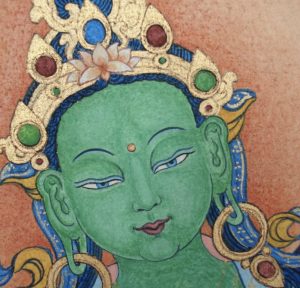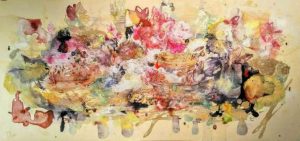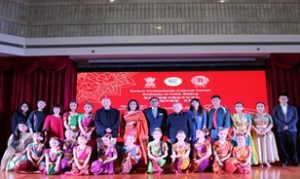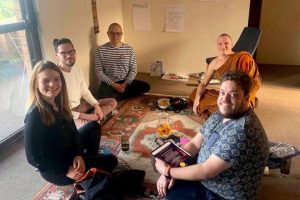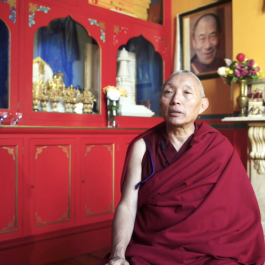Editor’s note: Eisel Mazard is a P?li scholar who has travelled extensively through Southeast Asia. In this interview, he shared with me his personal struggles in the volatile regions of Southeast Asia and his research on the Pali language in Yunnan Province, which are part of a wider, tragic story about the decay of Buddhist and Pali-teaching institutions in Southeast Asia. We cannot solve the urgent problems facing Buddhism and Pali studies in Southeast Asia if we do not face up to uncomfortable realities with honesty and courage. Check out Eisel’s blog here.
—
BDI: Let’s talk about the significance of P?li in southern Yunnan. Were it not for a very difficult and physically threatening period that you suffered, you would not have crossed the border from Cambodia into Yunnan. Yet as a result of this exile, you found that this Chinese region contains an Indic language written in Laotian, Burmese, and Thai fashions, all influenced by Cambodian script. Would you say this marked any turning point in your research life?
E.M.: Yes, the story that brought me to Yunnan (as a sort of refugee) is a funny story if you tell it in a funny way, and it is a sad story if you tell it in a sad way.
Immediately before I went to Yunnan, I was engaged in humanitarian work in Northern Laos. That area was devastated by the American War, so I had an interest in the contrasting situation that I would find across the border in Yunnan, where the same cultural traditions exist (with the same diversity of languages and ethnic groups), without the experience of that war.
The situation within Communist China is indeed fundamentally different: they never had a war with the Americans, but their experience of Communism was much more extreme (?j?D?i, ???Ƥj???R, etc.)than in Laos.
On the Lao side of the border, the villages were being re-built (and repopulated) after a situation of complete depopulation and general devastation. On the Chinese side of the border, all of the Buddhist temples had been destroyed, and most of the manuscripts were burned, but people still had shoes, and the buildings had permanent roofing, as the population had not been forced to flee (by contrast, in North-West Laos the U.S. military forced evacuations on foot, moving from village to village, with long-term effects that are in some ways more devastating than aerial bombardment).
Many of the Han Chinese in the big cities believe in the myth that the Cultural Revolution never even happened in the small villages and ethnic-minority areas of China; this is untrue, and there are many new publications that prove this isn’t true. The suffering, starvation and persecution in the countryside was extreme (although people in the big cities may have been unaware of it at the time). The long-term effects will continue to be felt for Buddhists, as this religion was especially targeted as a feudalist (?ʫ?)religion.
However, to give credit where it is due, I should also say that the Communist Party of China was a very good host to me and my research, in contrast to the Communist Party of Laos. I was exiled from Laos amidst death-threats from government officials, and the Lao people who had worked with me were forced to denounce me (for being a freethinker) at a formal Communist Party meeting. There were plenty of Lao government officials who liked me, who supported my work and thought that my research was important; however, nobody lifted a finger to help me (neither Lao people nor other foreigners). In Yunnan, I was “checked up on”, but surveillance was not very invasive: I was not beaten or oppressed in any way there.
BDI: You pointed out that over the last 50 years, there had been essentially no research done in this area. Yet, Yunnan seems to be the place where any presence of P?li will indicate intersecting, ancient information about medieval empires in Southeast Asia (the Cholas, Sri Lankan kings, etc.). Why have there not been more professors or students coming to Yunnan to do research?
E.M.: You are asking several different questions here.
First, you are asking if we would learn anything about cultural contacts with far-off places like Sri Lanka from the materials we can find within Yunnan. Well, we would learn something about the impact that Sri Lanka’s (exported) culture has had in Yunnan, and we would learn about the series of stages it passed through before arriving (some of it arrived via Cambodia, some of it arrived via Burma/Myanmar, and so on).
Although the most obvious forms of cultural exchange are indirect, the whole region is full of stories about particular books, particular statues, and particular monks arriving directly from Sri Lanka. The history of Therav?da culture being imported and emulated in Southeast Asia is more complex than anyone now understands: we have isolated records of armies and elephants being exchanged between Sri Lanka and mainland Southeast Asia, so we can imagine that if these exchanges were possible, it was relatively easy to trade books back-and-forth.
Although countries like Burma and Thailand present their own traditions in starkly nationalistic terms, they also acknowledge that this was (originally) an imported tradition, and that Sri Lanka had a unique importance as the middle path between India and Southeast Asia. Of course, that unique importance is predicated on the happenstance that India was conquered by Islamic armies, and that Sri Lanka wasn’t; for this reason, one small island became crucial to the survival of Therav?da Buddhism as we know it (rather than major centers of scholarship in India, Pakistan and even Afghanistan that we now only know as archaeological ruins, annihilated during the Islamic conquest).
In Northern Thailand (near the Lao border), I have seen an inscription stating that several of their monks were sent to study in Sri Lanka. Even if the inscription is not true, it reflects the fact that the local king on that part of the Mekong (at that time) believed it was important to boast about such a thing. This is the type of evidence we might be able to find in Yunnan, true or false.
Meanwhile, throughout Southeast Asia, there are many statues that people insist were made in Sri Lanka, although every art-historian knows that this isn’t true; however, it is still important to understand why people want to believe this is true; this is a fable with real cultural resonance, even in 2013.
In many ways, we are all struggling (in Therav?da Buddhism) to maintain some kind of connection with an intangible ideal from Sri Lanka’s past. This is the pathos of the religion in the 21st century, even for those of us who refuse to idealize the past.
To answer your other question, there is now one university professor teaching things related to Pali in Yunnan, called Yao Jue, in Kunming. The existence of that one professor may make some things possible for the next generation that were impossible for the last generation. Meanwhile, in Jinghong, there have been some small projects studying these historical materials, but I think they are delimited by the prevalent political conditions. They were able to conduct some kind of survey of manuscripts about traditional medicine and plants, but I think it would be impossible for them to do the type of research that I did myself, or even to ask the type of questions that I routinely ask on my blog.
BDI: You have noted some themes in the P?li literature of Yunnan: retellings of ancient P?li stories, possibly a translation or a commentary, or even notes about a sermon or ritual based on an original P?li text. The ways (at least three) in which P?li was mixed with other languages in these texts seem to give the impression that scribes found many diverse uses for this Indic language. Is the wide diffusion of P?li in Yunnan more or less due to the dominance of the medieval Indian dynasties, like the Chola, that exerted powerful cultural spheres of influence?
E.M.: In general, I warn younger scholars that everything you can see on the surface is the result of the most recent 300 years of history. In this context, I mean surface literally: archaeologists will dig up things that are more than 300 years old, but you are unlikely to encounter anything ancient that is still part of the living culture, above ground level.
The diverse texts that are now visible on the surface are not the result of any powerful kingdoms in India or Sri Lanka: they deserve to be celebrated as the accomplishments of tiny, powerless and poverty-stricken kingdoms that were indigenous to the area, and somewhat isolated by the mountains and jungles.
Within China, there is a cultural assumption that literature is something created at the center of the empire that radiates outward to the edges of the dominion. This is not true, and it is especially untrue of the Therav?da tradition. Local literary production was never the result of an empire’s dominance.
Very small polities were able to generate original literature (in their own vernacular, often with the ostentatious use of Pali to embellish it, etc.) and they were also able to maintain traditions that they had imported from India (in Pali, etc.) to a remarkable extent. In many ways, modern people can look at these societies and ask themselves, How much more could we accomplish if we really cared about literature and philosophy, instead of spending our time playing video-games? None of this was the result of an empire’s dominance, and none of it was the result of wealth being concentrated in one great capital city.
Instead, very small kingdoms devoted resources to creating and maintaining their own literature throughout Northern Thailand, Laos, and Yunnan. Despite the mountainous, malarial, impoverished conditions that define that whole region, you can find the remnants of a distinctive style of writing Pali manuscripts in almost every river-valley. This was important to these cultures: they devoted resources to supporting scholars and scribes, and they also had a vibrant popular literature, popular theatre, and so on. The local verncaular traditions both popularized Buddhist concepts and offered irreverent humor reflecting on the religion, social conditions, and other themes.
However, these cultures did not invent the airplane, they did not manufacture their own rifles, and they did not invent the atom bomb. The wars of the 19th and 20th centuries destroyed their independence, and both the authorship and readership for their distinctive literature disappeared. In reality, the last vestiges of their religion are disappearing right now. There are no more scribes, and the number of people interested in the local Buddhist textual tradition is very close to zero in any of these places.
BDI: In section 3 of your paper, you outline the many ways P?li was mixed with many other languages. Shouldn’t this be a subject of immense academic interest for scholars with the necessary language skills? Do we simply suffer from a dearth of such scholars?
E.M.: This time, I can give you a short answer: yes, and yes. Yes, this should be an area of immense interest, and yes, there is a dearth of scholars.
I could add that we also have a dearth of Buddhist charities (N.G.O.s) involved, or trying to make a positive difference in any way. Meanwhile, the Christian charities (and Christian missionaries) are ubiquitous.
Obviously, if you are going to start a Buddhist charity, you have many possible ways to make a positive difference in this world; however, I have seen a dearth of such charities everywhere I that have been (i.e., not only in Yunnan, but also in Cambodia, Laos, etc.). Meanwhile, the Christians are expanding their power and influence in these same places. Don’t ignore the example of modern South Korea: in just a few generations, Buddhism can become the minority religion in any of these countries.
Within Yunnan today, the vast majority of western scholars who have worked on minority languages are Christian missionaries, or are employed by Christian charities. Even though Pali is an expressly Buddhist language, the Christian missionaries have always been a significant percentage of the scholars. As Buddhists, we have to be willing to examine our own prejudices, and our own institutional failures.
BDI: Part 4 of your paper charts the history of P?li’s disappearance. You’ve outlined several practical lessons interested scholars need to learn. First, there needs to be cooperation in research and discovery. Academics need to start surveying the extant materials and cataloguing information from prior projects. Finally, they must be alerted about the work of cultural preservation, which will inevitably involve a more active role in guarding against the theft and trafficking of artefacts, manuscripts, and other pieces of heritage. But is there any “ethical” or “moral” lesson we can learn from the history of P?li’s disappearance in Southeast Asia? Is it as simple as a case of loss by imperialism, physical annihilation and looting?
E.M.: Well, I was formerly employed in the museum industry, and I attended many meetings that concerned the buyers and collectors who are at the other side of the equation. In terms of the economics of the problem, you can say that I have been a witness to both the forces of supply and demand. As you know, cities like Hong Kong and Bangkok are major centers for the auction and sale of these objects; Switzerland, also, is an important center for the trade. I never participated in this trade in any way (and I openly criticized other Pali scholars who did so) but I was certainly a witness to it, as it surrounded me.
Nobody can really be surprised to learn that human beings are motivated by money. The problem isn’t new. What we need are new solutions, and to provide meaningful alternatives for the people who are now involved in both buying and selling these things. When I was in Laos, an important manuscript about 300 years old was discovered, and it was then stolen within hours of the Europeans getting excited about it; sadly, it disappeared before they could photograph the text. Discovering things is dangerous; as soon as people recognize something as valuable, it can be stolen and sold. However, the larger problem is that everyone regarded the same manuscript as completely worthless before the Europeans discovered it. These two things are reciprocal: people steal and sell these things as a source of money, and they regard them as having no value aside from money.
It is hardly surprising that people fail to preserve a culture that they are themselves discarding; if you are willing to discard something as worthless, why would you be unwilling to sell it for a few dollars instead? I say this as a Buddhist myself: if we do not recognize the nature of the problem that we now have (as Buddhist institutions are collapsing, corrupt, and increasingly hollow) we will never take steps to improve the situation.
So, to answer your other question, no, the problem is not nearly as simple as the legacy of imperialism.
I have been in villages where all the teenagers gather in the chieftan’s wooden hut every night to watch TV soap operas broadcast from Thailand. I can say, honestly, that for the current generation these soap operas are more powerful than Buddhism, they are more powerful than Communism, and they are more influential than the legacy of Imperialism. This, also, is part of the challenge for cultural heritage preservation, but it seems to be even harder for people to face up to this than the legacy of Communism and Imperialism in the region.
BDI: Your long-time interest has been the P?li language and Southeast Asia, and so your paper about the disappearance of P?li must have been important to you personally as well as academically. What is the state of P?li scholarship today: how many P?li scholars are involved with conservation work and what are the general research trends P?li academics are focusing on?
E.M.: It is difficult to generalize about an area of research that involves very few people. Sadly, the number of scholars working with manuscripts and stone inscriptions is very close to zero. There was one scholar named Primoz Pecenko who had pointed out that completely “new” (previously unknown) manuscripts of ancient commentaries could be found in Burma, with very little effort, but he died after writing just one short article on the subject that “opened the door” for important research that (now) apparently nobody will ever attempt to do. He had also started some kind of comparative study of the version of various Pali texts preserved in stone inscriptions in Burma, but, again this research stopped suddenly with his death. For several years, I spoke to his widow, and I tried to help in any way that I could for this important research to continue, but then she suddenly disappeared. Extremely few people are even trying to do original research of this kind (and so it is a big crisis if even one person dies before teaching a “successor”).
For many years, I wanted to train with the (retired) specialist J. Filliozat, and I actually packed my bags and moved to Cambodia for that reason: she had told me that she was moving to Phnom Penh, and so I would be able to learn from her direct experience (of so many decades) of work with Pali manuscripts. However, she cancelled her plans at the last minute (without telling me), and she never did arrive in Phnom Penh! This was sad for me personally, but it is really a larger problem: Filliozat is aware that she retired without training a single person to be her “successor” (and she has expressed regret about this many times). Of course, it is also a problem that there was nobody else in Phnom Penh who could teach me anything. Filliozat has a lot of specialized knowledge (and hands-on experience) that will now disappear with her generation.
Although my own career was much shorter, whatever I learned will now go to waste, also. At the age of 34, all of my research potential is already at an end, and I can never return to the cause that I devoted my life to. I received fan mail from someone saying how interested he would be to read more of my translations, and I told him that I would find them very interesting, too – but it will be impossible for me to ever do such work. I had no teachers, and I will die without ever having students.
You ask one further question that would require a very long answer: what are the current trends that people are focussing on today? This is a huge topic, and in reply I can only encourage you to read my “huge” essay, titled “Problems of ‘Canon’ and ‘Reason’” (?n?Ǧ??Ь??s?????g??”?M“?z??”???D). This should be published in both English and Chinese eventually.To give a short answer: I understand that the structure of academic education makes it impossible for most people to do the type of research that I did, or even to attempt to study languages in the way that I did. I met several people with PhDs in Laos who had only spent a few weeks in Laos, whereas I was able to live there for two and a half years continuously. Generally, people design projects to be completed with the very short timeframe of a PhD program; after they have the diploma, they design government-funded research projects, which are even shorter and tend to serve some particular agenda. So, as with many things in life, the “fashion” tends to follow along after an economic or institutional impetus. As for myself, even the first stage of getting a PhD has proven to be impossible, and this relates to the end of my Pali career, along with all of the strange circumstances that I managed to survive in Laos.







